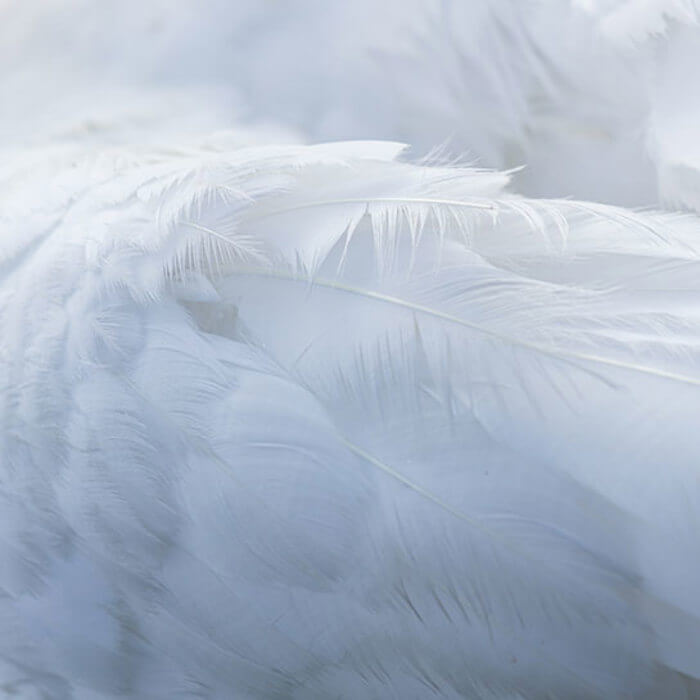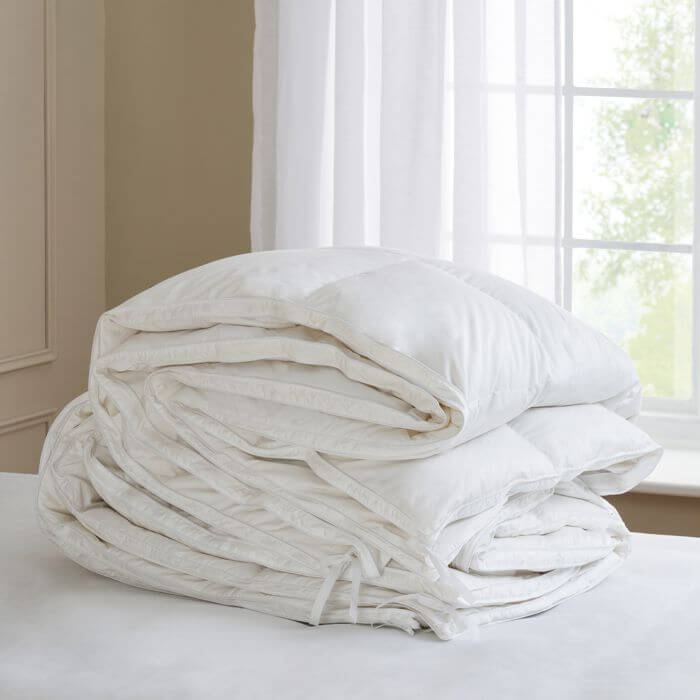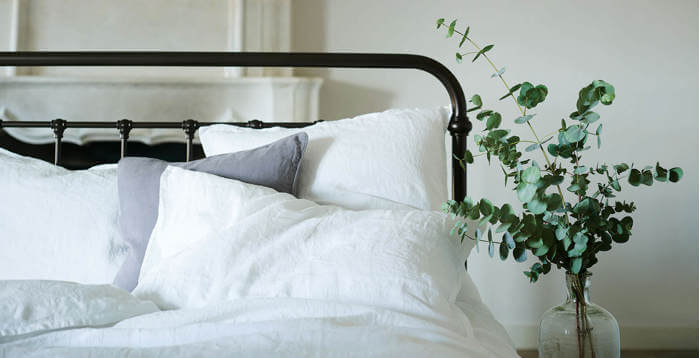Last Modified 22 December 2025 |
First Added 09 July 2020
Understanding the Difference Between Feather & Down
When creating the perfect sleep sanctuary, every element matters, from the crisp thread count of your sheets to the craftsmanship of your mattress and the plushness of your duvet and pillows. In your pursuit of the finest bedding, you may find yourself caught between the two luxurious options: down vs feather. Your search can leave you confused about which is best for you. Let us guide you through the subtle beauty of feather and down, revealing how each can elevate your sleep and transform your bedroom into a sanctuary of comfort and calm.
What is feather?
Feathers are sourced from the outer plumage of ducks or geese, typically from the wings and back. These feathers are larg and structured, with a central quill and branching vanes, designed by nature for flight and protection. In bedding, feathers provide a firmer, more supportive feel.
Feather-filled duvets and pillows offer a satisfying density, gently cocooning the body while maintaining breathability to prevent overheating. They provide a satisfying fluffiness that maintains its shape over time, ensuring consistent support night after night.
As feathers are more abundant than down, they offer exceptional value, making them a popular choice for those seeking luxury without compromise.
Our luxurious Duck Feather Pillow is filled with ethically sourced natural duck feathers and encased in silky smooth 100% cotton percale, for exceptional support and comfort.
What is down?
Down is the underlayer of feathers, sourced from the belly or chest of ducks and geese. These down clusters resemble tiny dandelions; soft, spherical plumules that trap air and offer exceptional insulation with minimal weight. Their structure allows for a lofty, cloud-like feel that envelops the body in gentle warmth.
Down bedding is the embodiment of indulgence. It conforms effortlessly to your shape, offering warmth without heaviness and a softness that feels almost ethereal. Its superior loft and breathability make it ideal for all seasons, while its longevity ensures it remains a worthwhile investment for years.

Understanding loft in bedding
Loft refers to the volume and fluffiness of a duvet or pillow, the quality that gives bedding its cloud-like appearance and determines how effectively it retains warmth. High-loft bedding feels plush and enveloping, creating a sense of weightlessness and warmth, while low-loft options offer a sleeker, more compact profile.
The loft of your bedding is shaped by the filling material and its ability to trap air. Down, with its airy clusters, naturally creates a higher loft, offering a pillowy softness that feels indulgent and luxurious. Feather, while slightly heavier, provides a more structured loft that supports the body with gentle firmness. Understanding your loft allows you to tailor your bedding to your sleep style, ensuring every night is restful and every morning is refreshed.
Duck vs Goose. Which is right for you?
The origin of your feather or down filling plays a significant role in the feel, warmth, and longevity of your bedding. Duck feathers and down are more readily available, making them a popular choice for those seeking accessible luxury. Duck down clusters are smaller, offering excellent insulation and softness, though with a slightly more grounded loft compared to goose.
Goose feathers and down, by contrast, are celebrated for their larger, fluffier clusters. As geese often inhabit colder climates, their down is naturally more insulating, resulting in bedding that feels warmer, loftier and exquisitely indulgent. While elevated performance commands a higher price tag, it’s a worthwhile investment for the added comfort and durability it brings to nightly rest.
For those seeking a blend of feather and down, our White Snow Duck Down & Feather Pillow is ideal. Generously filled with 60% down and 40% feather, its continuous support is ideal front and back sleepers.

Feather vs. Down Comparison
|
Feather fillings |
Down fillings |
|
Feathers are sourced from the outer layer of the bird, usually from the wings and back. |
Down is the fluffy undercoating sourced from the belly or chest. |
|
Feathers are heavier and flatter with sturdy quills. |
Down is lighter and airier, made up of fluffy clusters. |
|
Feathers provide firmness and structure, ideal for those who require ample support and a weightier feel while sleeping. |
Down's incredibly soft texture provides a luxurious sleeping experience, enveloping the body in gentle comfort. |
|
The sturdy composition of feathers ensures longevity and durability for long-lasting support. |
Down's superior thermal properties make it ideal for maintaining a comfortable sleep temperature in any season. |
|
Feathers, though warm, require a higher fill power to achieve the same level of insulation, resulting in a heavier, bulkier feel. |
Despite its insulating prowess, down is remarkably lightweight, allowing for a lofty feel without added bulk. |
|
Feathers offer a budget-friendly option without compromising on quality. |
The exceptional quality of down comes with a higher price tag, making it a premium option in luxury bedding. |
Caring for the feather & down bedding
Luxury bedding is considered an investment — one that, with thoughtful care, can offer years of comfort and restorative sleep. Yet even the finest duvets and pillows will eventually show signs of wear.
Telltale signs that it’s time to refresh include flattened or clumped filling, diminished warmth, or a noticeable decline in comfort and loft. These subtle shifts can affect the quality of your sleep and the elegance of your bedroom aesthetic.
To ensure your bedding remains at its luxurious best, explore our expert guide to bedding care, where you’ll find thoughtful advice on how to preserve softness, loft and longevity. And when the time arrives to replace your bedding, our curated collection of feather and down-filled duvets and pillows awaits.

Shop feather and down at Feather & Black
Discover the art of considered comfort with Feather & Black. From the grounded support of feather to the cloud-like softness of down, our curated collection of luxury bedding is crafted to elevate every night into something truly restorative.
Shop feather and down bedding
If you need further information on finding the best bedding for you, browse our Bedding Guide.